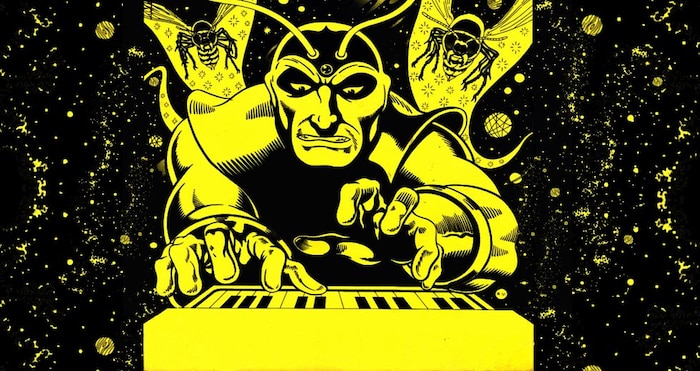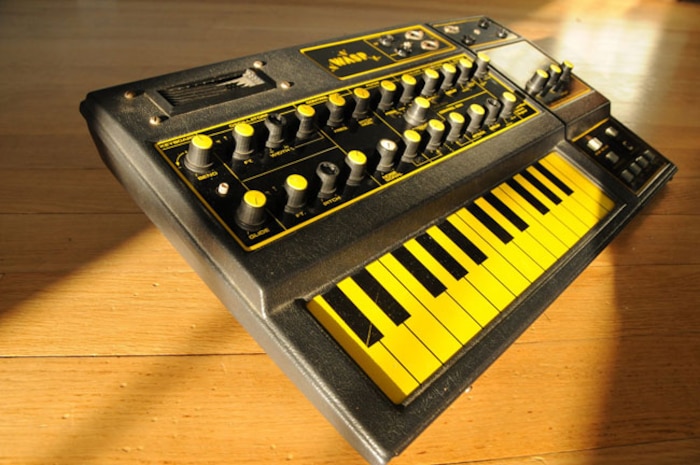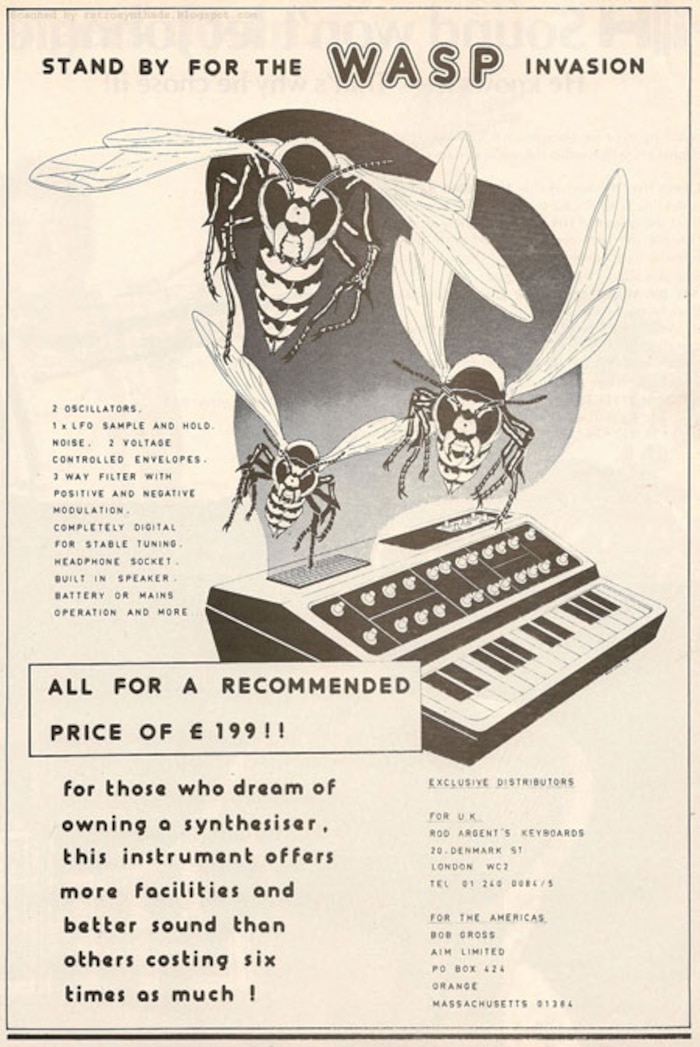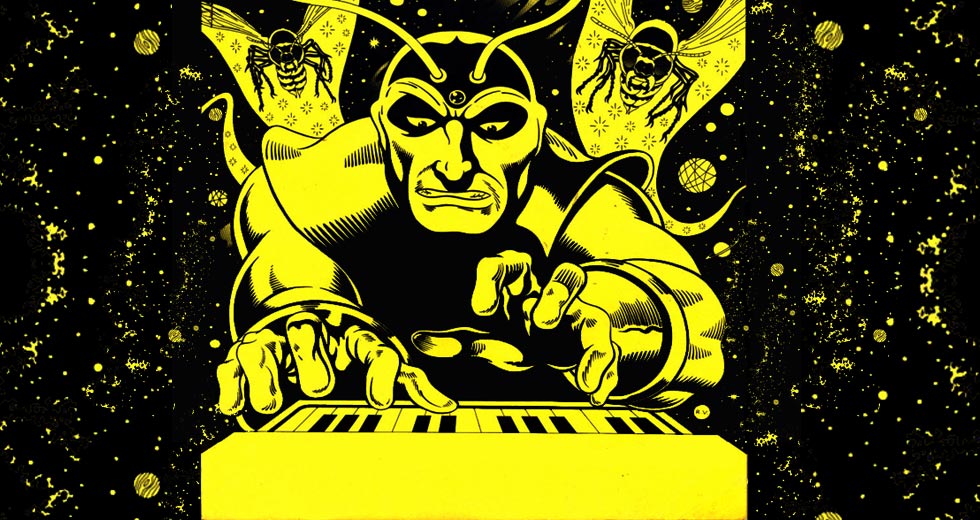Synth-Aesthesia: The Wasp

Although the dangerous-looking synth was only in production for a few short years, the Wasp caused quite a commotion when it first came out at the tail end of 1978. Arriving at the dawn of what was to be a synthesized revolution in the UK, it brought a distinctly characterful sound to England’s punky, industrial landscape and inspired a generation of young musicians to get stuck into volts and oscillators. In this month’s edition of Synth-Aesthesia, Max Cole speaks with Chris Carter and Thomas Leer to look back on the legacy of Electronic Dream Plant’s Wasp synthesizer.
When the Wasp first landed, there was no denying it stood out. “I remember going into Rod Argent’s shop with Robert Rental,” says Thomas Leer. “Like everybody else, I was looking at ARP Odysseys and Minimoogs, but I was broke, so the Wasp was the only option for me. We messed about with it and thought, ‘Actually this thing is pretty good!’ The sound was instant and powerful, they had it hooked up to a Peavey amp, and it just blasted through the shop. I was like, ‘This is the one for me!’, and bought it on the spot.”
Indeed the Wasp looked and sounded the complete package. It stood out from other synths and packed a surprisingly powerful sound from its unassuming plastic case and flat keyboard. The sound lived up to its name, matching its distinct colours, and the early adverts even hinted at a rather terrifying swarm of sound waiting to be unleashed. “When I saw the first ad, I was intrigued by the look,” recalls Chris Carter. “It was pretty different to most keyboard synths on the market. The plastic case, the keyboard and the size had echoes of the EMS Synthi AKS keyboard, but the colour scheme and the layout were very different. Then I saw the low price and high specification, and realised this little synth was going to be a serious game-changer for a lot of struggling electronic musicians.”

This democratising ethos seems to be one of the main ideas behind the Wasp. The two men responsible, synthesist Adrian Wagner and designer Chris Huggett, set out to make the Wasp as easy on the wallet as possible, without compromising on flexibility and sound quality. A clever mixture of digital components supported the analogue filter, and the vastly more expensive microprocessor option (as used by Sequential for their Prophet 5) was avoided for transistor logic circuits. The result was a synth that was within everyone’s budget, and bands and keyboard players didn’t need to mess about programming sounds – they could start getting ideas down straight away.
“The architecture of the thing meant that everything was patched already, it was ready to go,” says Leer. “If you didn’t want to use your ADSR [Attack-Decay-Sustain-Release], you just set it to nought and the sound would just go through. Same with the filter, which meant that it was brilliant for learning about voltage controlled synthesis. All you had to do was move the knobs about and remember where you put them.”
In 1979, Thomas Leer and Robert Rental got an eight-track recorder and mixing desk, and set about making an album. The Bridge was one of the first LPs on Throbbing Gristle’s Industrial Records, and its mixture of raw electronics, disembodied vocals and fuzzy ambience fell somewhere between Throbbing Gristle’s own industrial explorations, Bowie’s Low, Fripp and Eno’s hypnotic improvisations and John Foxx’s haunting machinic eulogies.
“The Bridge is all Wasp,” confirms Leer. “There’s no other synth on there. We did side one in the first week, and then set off doing the more ambient stuff in the second week. Two days for mixing and that was it. The Wasp was like a punk rock synthesizer, because it was cheap and nasty and it did the job – and that allowed people who couldn’t afford a Korg or whatever to get on with it.”
There was a certain fearlessness to the Wasp, and despite its fragile casing, it housed a host of unusual features. While some saw the flat, touch-sensitive two octave keyboard as a drawback, Chris Carter saw it as a chance to play the machine in an unconventional way: “It was easy and fun to use. Sliding your fingers across the keys produced that classic Wasp arpeggio effect that you can’t do with a regular keyboard.”
On Leer’s model, the keypad’s sensitivity could go into overdrive. “After I’d been using it for about a year, I could just hold my hand above it, and not even touch it, and it would play. In fact, people think I’m crazy, but I swear I could play it with my eyes. I could just look at the top and it would go up in pitch, and if I looked at the bottom it would go down. Probably it was just my hands waving around, but it got so sensitive that you could just wave your hands above it and it would change pitch.”
“The Wasp was like a punk rock synthesizer, because it was cheap and nasty and it did the job.”
Another unique aspect was the seven-pin DIN connector interface, which allowed several Wasps to be linked together and be played from one control keyboard. In a way it prefigured MIDI, digitising various parameters of the synth in a two way connection, but the technology to reliably connect a swarm of Wasps was not quite developed yet. Notoriously difficult to get to work, EDP followed the DIN interface with their own sequencer, the Spider, although that too was often even more unpredictable.
Another feature was the built-in speaker, so if you didn’t have access to an amp, it was still possible to terrorise the neighbourhood through its raspy tweeter. Combine that with a pack of six HP11 batteries and it was truly mobile, and a million miles away from the truckloads of modular gear that bands like Yes and ELP carted around only a few years earlier. “You could literally put it in a bag and take it with you anywhere,” says Leer. “Plug it into the PA system with a couple of effects and it sounded great!” Chris Carter recalls buskers around Covent Garden doing a roaring trade with a Wasp, effects pedals and a Boss Dr Rhythm, and rumour has it Hawkwind took a couple of them on the London Underground and re-routed the passengers of one carriage deep into the black corridor.

Robert Rental was one of the earliest musicians to put the Wasp through its paces in a proper gig setting when he joined The Normal for the live incarnation of Daniel Miller’s project. Their mixture of drum machines, chunky Wasp riffs, waves of gritty electronic noise and generally dystopian tone inspired a whole cottage industry of home studios, DIY cassette labels and mailing lists. Rough Trade released a live performance of the duo at North Norfolk’s West Runton Pavilion from March 1979, and the single-sided 12" has since come to define one of the moments on the live circuit when the guitar-centric status quo was being turned upside down. “I went to a gig where The Normal and Robert were supporting Throbbing Gristle, and the response was really good,” says Thomas. “There were a lot of people who were open to that, at the time. People wanted to try out new ideas and listen to weird stuff.”
Throbbing Gristle were at the helm of this different attitude to music and social norms. From industrial sounds and experimental, provocative live shows, TG were sooner likely to release William S Burroughs’ cut and paste poetry recordings than a traditional guitar record. The Wasp played its part in much of Carter’s output after TG split in 1981, cropping up on all his solo albums and Chris & Cosey records. Carter’s approach to recording meant that the Wasp wasn’t so much singled out, as woven into the sound fabric of his studio, finding its place among the hive of his custom-built synths and ‘Gristle-iser’ effects. “I had my Wasp for more than 20 years, so that’s a lot of recordings,” counts Chris. “I’ve said this before, but when we’re recording, I’m very much in the moment, and because we layer so many sounds I find it difficult to remember exactly what or how I used a particular instrument on a specific track. Although, admittedly listening back to our tracks I can usually pick out the instruments we’ve used. It was a running joke we had with Sleazy that none of us could ever remember how we recorded most of what we’ve done over the years.”

But that’s part of the charm of the Wasp, it wasn’t about saving settings and reproducing the same sound again and again. There was an immediacy and an urgency to it, a tiny twist of a knob could change the sound completely. As the UK’s musical landscape found itself on a wave of ubiquitous synthesis, the Wasp was there to keep everyone on their toes. EMS Synthi, Korg and Roland keyboards were very popular, and were just on the high side of affordable. But American Moogs, ARPs and the like were quite rare amongst independent bands because they cost significantly more than the UK and Japanese brands. For all its unusual design and high quality sound, the Wasp arrived with the promise of making things happen. There was no more daydreaming of modules out of your price-range; the Wasp shook dispelled daydreams and jolted musical ambitions.
In the end, it’s estimated 3000 Wasps were made over the three years between 1978–81, and in some ways their affordability was their Achilles heel. The plastic case and lightweight body meant they were easily damaged, and often it was cheaper to buy a new Wasp than to repair a broken one. This gave them a certain disposable quality, with many left unrepaired. “A brand new Wasp was pretty stable, but after a few months of gigging their personality could change drastically – for the worse, unfortunately,” admits Carter. “But that just meant you had to adapt your playing techniques to accommodate its foibles.”
A working Wasp these days is a rarity, and could easily cost you six times the original retail price, in an ironic twist to the claim in its early adverts. However, the legacy of the Wasp is not as a collector’s piece, but that in its short life it kick-started a generation on the cusp of a new electronic age, and played a short but pivotal role in shaping the sounds of many influential groups. Sometimes the biggest catalysts can be found in the smallest places.
